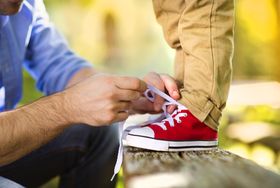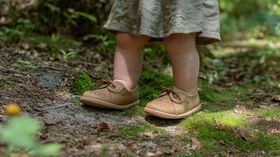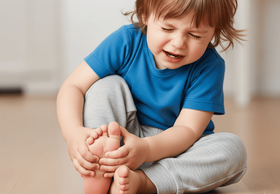How to Fix Overlapping Toes in Babies & Toddlers
Overlapping toes in babies can often be corrected at home using gentle taping and stretching when started early. Research shows 94% success with treatment begun within the first 10 days, and most cases resolve within 3-4 months with consistent care.
Updated October 15, 2025

You're changing your baby's diaper when you notice one toe resting on top of another. The pinky toe seems to cross over its neighbor, and you're wondering if this will cause problems for your toddler's foot development or if there's something you should do.
Well, this isn't a rare situation. 2.8% of newborns are born with overlapping toes, and it's one of those things that catches parents by surprise [1]. Now, let's look into whether there's any cause for concern and how you can help fix your little one's feet.
What Overlapping Toes Look Like
When babies' toes overlap, you'll see one toe (usually the pinky or fifth toe) resting on top of the toe next to it. The affected toe often appears rotated outward, and the toenail might not be visible when you look at your baby's foot from above.
This is different from toes that are painful or that just curl slightly or touch each other. True overlapping means one toe is positioned on top of another and tends to stay that way even when you try to gently separate them.
Expert Note: From my experience, about 25% of cases improve naturally as your baby grows and moves more. The remaining 75% benefit from early treatment, which is usually straightforward when started early.
What Causes Overlapping Toes in Babies
The most common cause of toes overlapping is simply your baby's position in the womb. Babies spend months curled up in a small space, and sometimes this positioning affects how their toes develop. This is completely normal and doesn't mean anything went wrong during pregnancy.
There's also a genetic component. If you or your partner had overlapping toes as a baby, your little one has a higher chance of having them too [2]. This hereditary factor means parents with multiple children might notice the condition appearing in siblings.
The important thing to understand is that overlapping pinky toes on your baby's flat feet aren't caused by anything you did or didn't do. It's simply how your baby developed in the womb, and it's very treatable.
When Your Baby's Overlapping Toes Need Treatment
Treatment works best when the overlapping toe feels rigid rather than flexible—meaning you can't easily move it into the normal position. If the toe immediately springs back to the overlapped position when you release it, gentle intervention will help.
You might also notice the toenail isn't visible from above because of the rotation, or there's redness where the toes touch. If there's no improvement after the first month, or if the overlap prevents your baby's foot from lying flat, these are signs that simple home treatment will make a difference.
When to Talk to Your Pediatrician About Your Baby's Overlapping Toes
While most overlapping toes can be addressed at home, talk to your pediatrician if you notice color changes in the affected toe—anything bluish, white, or persistently red. Swelling, warmth, or any signs of infection also need immediate attention.
If the toe appears painful when touched or if your baby cries during diaper changes, get it checked. You should also consult your healthcare provider before trying home treatment if your baby was born prematurely or has other developmental concerns.
How to Fix Your Child's Overlapping Toes at Home
1. Taping Your Child's Overlapping Toes
If you're wondering how to tape your baby's overlapping toes, you'll need medical-grade hypoallergenic surgical tape about 1/2 inch to 1 inch wide. This type is gentle on newborn skin while providing adequate hold. Avoid regular athletic tape or anything with aggressive adhesives.
Here's the simple process:
- Start with clean, dry skin. No lotion or moisture that could prevent sticking.
- Position the toe correctly. Gently guide the overlapping toe into its proper position next to the neighboring toe. Don't force it—use gentle, steady pressure.
- Anchor to the stable toe first. Start wrapping from the toe that's in the correct position, not the affected toe.
- Wrap with gentle pressure. The tape should feel like a comfortable sock, not a tight bandage. You should be able to slide a fingernail edge underneath.
- Check circulation regularly. The toe should look the same pink color as the other toes. If it looks darker, lighter, or feels cool, remove the tape immediately.
- Change the tape every 3-5 days. This gives enough time for positioning to work while preventing skin irritation.
2 Gentle Stretching of Your Child's Overlapping Toes
Along with taping, gentle stretching helps. During diaper changes, 3-4 times daily, gently massage your baby's foot for about 30 seconds. Then hold the stable toe with one hand while guiding the overlapping toe toward the correct position with your thumb and index finger.
Use very gentle pressure—about what you'd use when testing if fruit is ripe. Hold each stretch for 10-15 seconds, repeat three times. If your baby cries or fusses a lot, you're using too much force. Never stretch an inflamed or irritated toe.
3. Choosing the Right Footwear While Treating Your Child's Overlapping Toes
Hold off on shoes until your child is taking independent steps. Barefoot time during early development benefits toe strength. Once your toddler is walking, choose shoes for wide feet with a wide, rounded toe box that lets toes spread naturally.
Avoid pointed or narrow toe boxes that push toes together. The sole should bend easily at the ball of the foot. Let your baby wear soft-soled shoes. Never use hand-me-down shoes—they've molded to another child's foot shape and can work against your treatment.
What to Expect During Treatment of Your Child's Overlapping Toes
Understanding the timeline for seeing improvement in overlapping toes helps you stay consistent. Here's what typically happens:
- Weeks 1-2: You'll notice the toe moves more easily into the correct position during changes
- Weeks 3-4: The toe shows noticeable improvement, holding better alignment for several minutes after tape removal. The overlap usually reduces by about 25-30%
- Weeks 6-8: Significant change appears. The toe may hold the correct position for hours after tape removal
- Weeks 10-12: The toe maintains proper position without support
How the Starting Age Affects Fixing Overlapping Toe Results
Timing makes a huge difference. When you begin treatment within the first 10 days of life, success rates reach 94%. Treatment typically takes 3-4 months with consistent care.
Starting after 30 days still offers good outcomes, but treatment may extend to 5-6 months. After three months, it becomes more challenging, possibly taking 6-8 months or requiring professional help.
This is why acting quickly when you notice overlapping toes matters more than taking a "wait and see" approach. Those early weeks make correction so much easier.
Fixing Your Child's Overlapping Toes
If there's one important lesson about how to fix overlapping toes, it's that timing determines everything. Every week of delay during the first three months reduces how well the treatment works.
The difference between starting at two weeks versus two months can mean three months of taping versus six months of intensive treatment. Trust your instincts. If your baby's toes appear overlapped, act quickly. Early intervention transforms a minor concern into something highly correctable.
As your baby grows, choosing shoes with wide toe boxes helps maintain the correction you've achieved. Orthopedic-friendly footwear gives your child's toes room to spread naturally without compressing them back together. The right shoes support the healthy alignment you've worked to establish and promote continued proper foot development as your little one grows.
References
Smith, W. G., Seki, J., & Smith, R. W. (2007). Prospective study of a noninvasive treatment for two common congenital toe abnormalities (curly/varus/underlapping toes and overlapping toes). Paediatrics & Child Health, 12(9), 755–759. https://doi.org/10.1093/pch/12.9.755
What to know about overlapping toes. (2024, February 25). WebMD. https://www.webmd.com/pain-management/what-to-know-overlapping-toes
Disclaimer: First Walkers' information is intended for educational and informational purposes related to toddler footwear and feet. We encourage you to consider individual circumstances and consult qualified orthopaedists about specific conditions.
FAQs
Will overlapping toes affect my baby's ability to walk?
No, successfully treated overlapping toes don't affect walking development. When corrected before your child starts walking independently (usually by 8-12 months), children develop completely normal walking patterns with no delays or differences.
Can I give my baby baths with the tape on?
Yes, keep the tape on during brief baths. Medical tape maintains adhesion when wet if applied to clean, dry skin initially. Keep baths under 10-15 minutes and pat the tape dry afterward. Change tape on your regular schedule (every 3-5 days) rather than after every bath.
My baby keeps pulling the tape off—what should I do?
This is a common curiosity behavior. Try covering the tape with a sock to reduce access, or distract your baby immediately after applying tape. If removal becomes constant, apply tape after feeding when your baby is drowsy and more likely to accept it.
Do overlapping toes run in families?
Yes, overlapping toes show significant genetic predisposition. If you or your partner had overlapping toes as a baby, your children have a higher risk. For subsequent babies, examine feet within 48 hours of birth and monitor weekly during the first three months.
Should I tape all my baby's toes if several look crooked?
No, only tape toes showing definite overlap that immediately return to the overlapped position when released. Many newborns show minor positional variations that self-correct within weeks. Taping unnecessary toes can create problems, so focus only on true overlapping.





